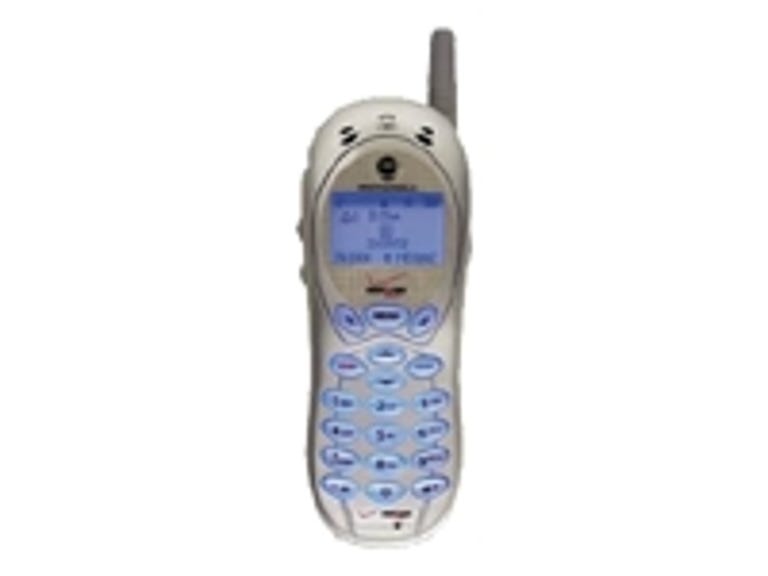Though the V120x looks virtually identical to last year's V120c for Verizon Wireless service and has similar features, the V120x offers a few enhancements, including compatibility with next-generation (3G) 1xRTT voice networks. Like the earlier model, it doesn't excel in one particular area. However, it's well suited for someone who's looking for a practical, relatively inexpensive phone that offers attractive cosmetics and add-on accessories, decent battery life, a sturdy design, and compatibility with next-generation voice networks.
The V120x, which comes in a silver finish instead of the V120c's Black or Skye Blue, is exactly the same size and shape as its sibling (5.0 by 1.7 by 1.1 inches; 4.5 ounces), and its screen shares the same raised, protective covering that tends to attract the natural oils of your skin when the phone's pressed against your face. Covering the phone with any of the 11 optional $9.99 soft PhoneWraps helps the ergonomics and makes the earpiece less slippery. And speaking of the screen, it's a bit small, displaying only three lines of text in wireless Web mode.
On a more positive note, the V120x's backlit, rubberized buttons have a nice feel, and the phone's interface, though not stellar, is straightforward. Along with such standard features as caller ID and call history, there's a 500-number phone book, 32 preset ring tones, 32 customizable ones, a vibrate mode, voice-activated dialing for up to 20 names, three rudimentary games, and a voice-recording feature that allows you to tape two minutes' worth of voice memos.
Another plus: This model is compatible with the company's FM radio and MP3 player accessories. They plug into the bottom of the phone and double as hands-free headsets, with the mike built into the cord. The V120x is also capable of two-way SMS (short message service), and using the optional software/cable package, it can sync with popular PIMs such as Microsoft Outlook. Overall, we were impressed with the V120x's battery life, even though, like with the V120c, our test numbers fell short of Motorola's figures. We still managed to get nearly five days of standby time (Motorola says you can get up to 350 hours) and a little more than 3.5 hours of talk time, compared to Motorola's claims of up to 210 minutes. It's worth pointing out that these numbers may improve once 1xRTT voice networks are up, as improved handset battery life is allegedly one of the benefits of next-generation services.
Soundwise, the trimode V120x (CDMA 800/1900/AMPS 800) was a mixed bag. Occasionally, we found it difficult to find the earpiece's sweet spot, but once we did, call quality was generally good on Sprint's network in New York City and San Francisco. We rarely had to extend the retractable antenna to get a strong signal.
On a more positive note, the V120x's backlit, rubberized buttons have a nice feel, and the phone's interface, though not stellar, is straightforward. Along with such standard features as caller ID and call history, there's a 500-number phone book, 32 preset ring tones, 32 customizable ones, a vibrate mode, voice-activated dialing for up to 20 names, three rudimentary games, and a voice-recording feature that allows you to tape two minutes' worth of voice memos.
Another plus: This model is compatible with the company's FM radio and MP3 player accessories. They plug into the bottom of the phone and double as hands-free headsets, with the mike built into the cord. The V120x is also capable of two-way SMS (short message service), and using the optional software/cable package, it can sync with popular PIMs such as Microsoft Outlook. Overall, we were impressed with the V120x's battery life, even though, like with the V120c, our test numbers fell short of Motorola's figures. We still managed to get nearly five days of standby time (Motorola says you can get up to 350 hours) and a little more than 3.5 hours of talk time, compared to Motorola's claims of up to 210 minutes. It's worth pointing out that these numbers may improve once 1xRTT voice networks are up, as improved handset battery life is allegedly one of the benefits of next-generation services.
Soundwise, the trimode V120x (CDMA 800/1900/AMPS 800) was a mixed bag. Occasionally, we found it difficult to find the earpiece's sweet spot, but once we did, call quality was generally good on Sprint's network in New York City and San Francisco. We rarely had to extend the retractable antenna to get a strong signal.
Score Breakdown
Design 6Features 6Performance 7



